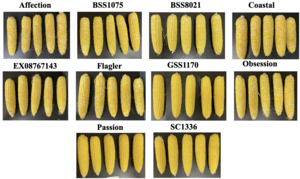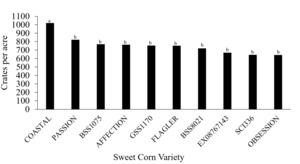Introduction
Cultivar selection is the first step of any farm operation that allow growers to maximize crop yield and quality. Sweet corn growers must select cultivars with high yield potential but also adaptable to the environmental conditions of their farm. Particularly, ear size or dimensions, number of ears per plant, number of kernels, and other ear parameters are very important to ensure desirable yields and profit.
In Alabama, sweet corn is grown across the entire state, but cultivars grown in the south might not perform well in the center or north portion of the state. Consequently, an evaluation of the performance of commercial cultivars is required to assist growers with decision making. Thus, this study was conducted during spring of 2021 in southwest Alabama (Brewton Agricultural Research Unit from Auburn University) and central Alabama (E.V. Smith Research and Extension Center from Auburn University) to evaluate ten commercial cultivars (Table 1) under conventional crop management practices.
Sites, crop management, and results
Location: Southwest AL – Escambia County, Brewton – AL
Crop management practices:
-
Planting date: March 23, 2021
-
Row spacing: 36 inches
-
In-row plant spacing: 6 inches
-
Plant population: 29,040 plants/acre
-
Plot size: 80 plants per plot
-
Harvest date: June 16, 2021
-
Crop management: Practices associated with soil preparation, irrigation and management of pest, weeds and diseases followed by standard practices.
-
Weather conditions: Maximum and minimum daily air temperature and rainfall was monitored using an in-site weather station.
-
Data collection: At maturity, sweet corn ears harvested and total yield, number of ears per plant, ear weight, ear diameter, ear length, kernel rows, kernel grains in a row, and kernel total grains were recorded. All data was used for statistical analysis and cultivar comparison. Statistical analysis was performed using the RStudio software, using the Fisher’s Least Significant Difference Test with a p-value of 0.05.
Results
In southwest AL, sweet corn was harvested 85 days after planting. Daily air temperature averaged 69 °F while rainfall events accumulated 17.5 in. Heavy rainfall events, at 17, 33, 43, 47, 50, and 73 DAP, created waterlogging conditions. Despite these events, there were optimum daily air temperatures (60 to 85 °F) for sweet corn development.
Figure 3 shows sweet corn yield according to cultivar, while table 2 shows ear quality according to cultivar. Overall, sweet corn yield was the highest for cultivar Coastal (1020 crates/acre), while there was no significant difference among all other cultivars. Coastal also head the heaviest and most width ears, which average 1.38 lb and 2.21 inches, respectively.
Location: central Alabama – Elmore County, Tallassee – AL
Crop management practices:
-
Planting date: April 14, 2021
-
Row spacing: 36 inches
-
In-row plant spacing: 6 inches
-
Plant population: 29,040 plants/acre
-
Plot size: 80 plants per plot
-
Harvest date: July 1, 2021
-
Crop management: Practices associated with soil preparation, irrigation and management of pests, weeds, and diseases followed by standard practices.
-
Weather conditions: Maximum and minimum daily air temperature and rainfall was monitored using an in-site weather station.
-
Data collection: At maturity, sweet corn ears harvested and total yield, number of ears per plant, ear weight, ear diameter, ear length, kernel rows, kernel grains in a row, and kernel total grains were recorded. All data was used for statistical analysis and cultivar comparison. Statistical analyses were performed using the RStudio software, using the Fisher’s Least Significant Difference Test with a p-value of 0.05.
Results
In central AL, sweet corn was harvested 78 days after planting. Daily air temperature averaged 73.4 °F while rainfall events accumulated 11.9 in. In general, weather conditions were optimum for crop development, there were few heavy rainfall events while daily air temperatures were within the optimum range for sweet corn growth (60 to 85 °F).
Figure 5 shows sweet corn yield according to cultivar, while table 3 shows ear quality according to cultivar. Overall, there were no significant difference among cultivars for yield or ear parameters, indicating that all cultivars are adaptable to the central AL conditions.
Conclusion
Heavy rainfall events, unpredictable heat and drought stresses, and frequent high-temperature fluctuation create challenges during crop growing seasons. The selection of a proper cultivar can help growers to overcome these challenges. Cultivar Coastal had the best performance for the environmental conditions of south AL in 2021, which was characterized by heavy rainfall events during season that created waterlogging conditions. All cultivars performed the same in center AL during that year, when weather conditions were optimum for sweet corn production.


_during.png)

_during.png)


_during.png)

_during.png)
